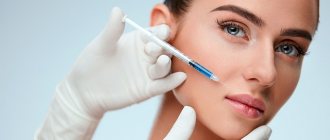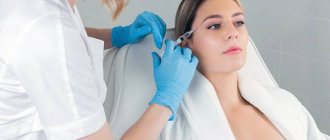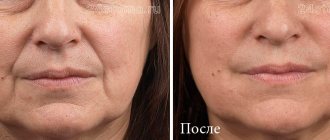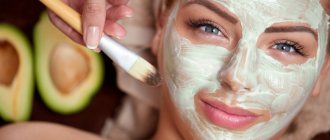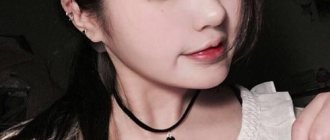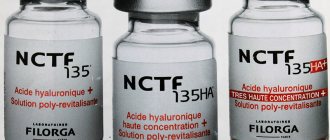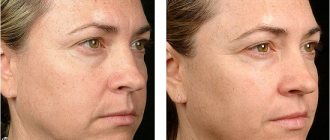Nappage technique
(superficial mesotherapy, “bedspread”, “picottage”)
This technique is a series of frequent injections. The approximate volume of the drug administered in each injection is 0.02 ml. Depending on the depth of drug administration, superficial, medium and deep nappage are distinguished.
Superficial nappage
Superficial nappage – administration of drugs to the epidermal level, depth no more than 0.5 mm. For this technique, it is more convenient to use short mesotherapy needles (4 mm). The needle is held with the cut side up.
The tilt of the needle does not matter and can be 30-90 degrees. The drug is injected to a depth of no more than 0.5 mm, at 1/3 - 2/3 of the needle cut. The distance between injections should be no more than 0.5 -1 cm.
This technique is used to treat the area of the face, neck and décolleté along massage lines. If the superficial massage is performed correctly, there should be no “blood dew”, since the injections do not reach the papillary dermis.
Superficial nappage is used to introduce any cocktails with the exception of preparations with a gel consistency.
It is not advisable to use expensive cocktails with this injection technique, since the bulk of the drugs remain on the skin due to the shallow injection depth. Part of the drug is then absorbed, but with nappage the loss of the drug is up to 50%.
Dry nappage. It is possible to carry out surface nappage without using a cocktail - the so-called “dry nappage”.
Medium nappage
Medium nappage. Injections are performed at the level of the dermis, at the depth of the papillary or reticular layer. This technique is used mainly in the treatment of vascular diseases of the face and body, as it allows the delivery of medicinal substances directly to the choroid plexuses of the dermis.
When working with the face, the angle of the needle is 45 degrees, the insertion depth is 1-1.5 mm, the distance between injections is 1-2 cm. The needle is held with the cut facing upward.
Injections are carried out along the vascular pattern or along massage lines. It is possible that droplets of blood may be released at the site of some injections on the surface of the skin and the formation of microhematomas, as damage to the walls of blood vessels occurs.
Deep nappage
Deep attack, deep mesotherapy. This technique is also called “infiltration”. Deep nappage is used only in mesotherapy treatment of the body for the purpose of correcting local fat deposits and in the treatment of cellulite.
The depth of administration of cocktails should be at least 10 mm, since the drug must be delivered to the subcutaneous fatty tissue. To perform deep nappage, needles 13 mm long are used. The needle angle is 90 degrees.
Using deep nappage, mainly lipolytic drugs are administered.
Types of techniques
When performing a mesoprocedure using the nappage technique (shown in the photo), skin damage is minimized and most of the dermis receptors are activated.
Injections occur with an interval of 3 seconds, while 0.02 - 0.05 ml of the product enters the cells.
There are three types of nappage technique:
- deep;
- surface;
- median.
Deep type
Or, as they also say, infiltration is carried out at the hypodermal level.
This manipulation is mostly used during body mesotherapy, when it is necessary to introduce lipolytic or lymphatic drainage meso-cocktails that ensure the elimination of fat and cellulite.
This method requires a needle measuring about 13 ml. The angle of inclination is 90 degrees, injections are reproduced to a depth of up to 10 mm.
Surface type
When implementing this technique, the product is delivered to the epidermal level. For the most part, this method is practiced for mesotherapy of the décolleté, neck and face. And it has several characteristic features:
- shortened needles (4 mm) are used;
- the product is injected along the massage lines;
- punctures are carried out at a distance of up to 1 cm;
- the injection is reproduced no deeper than 0.5 mm;
- the needle is held with the cut side up.
Also watch the video from which you will learn about the superficial type of nappage:
Using this method, a large number of elements are introduced in addition to those that have a gel-like consistency.
Middle type
With this technique, the active substances enter directly into the dermis, at the papillary or reticular level.
The length between injections is 1.5 – 2 cm. Injections are carried out to a depth of approximately 1.5 mm. The tilt of the needle when working with the face is 45 degrees.
Injections are made along vascular lines or massage lines.
This technique is intended for mesoprocedure of hair, blood vessels, stretch marks, and for smoothing skin texture.
Mesoinfiltration is a popular technique for administering mesopreparations
Infiltration (mesoinfiltration) is an additional technique for introducing mesopreparations at the hypodermal level to a depth of 6-13 mm. The purpose of this technique is to create a depot of meso-cocktail, which will indirectly affect the problem area.
Mesoinfiltration is performed after a classic mesotherapy course, including a vascular stage, a classic mesotherapy session, as well as drainage and metabolic stages.
The main directions of this technique: lipolytic, defibrosing, drainage and metabolic effects.
In aesthetic medicine, infiltration is used to correct local fat deposits on the face and body, cellulite, in particular: the oval of the face and the “double” chin, the “menopausal hump” - the area of the 6-7 cervical vertebrae, the outer and inner surfaces of the hips and shoulders, the abdominal area and lower back, the “breeches” area, treatment of hydrolipodystrophy (location of the “orange peel”). Infiltration has also found its application in sports medicine, traumatology and rheumatology due to its analgesic, anti-edematous and anti-inflammatory effect.
The technique of this mesotherapy method, despite the deep and volumetric administration of drugs, is the least painful and least traumatic when performed correctly. An attentive and caring doctor can only encounter such unpleasant sensations that patients experience, such as a feeling of fullness and small hematomas due to damage to blood vessels in the hypodermis. But patients informed in advance will undergo the procedure much easier and more comfortable.
In modern aesthetic medicine, infiltration mesotherapy technique is divided into two independent methods: mesodissolution and mesoperfusion.
They differ either in the rate and dose of the mesomedicine administered, or in the chemical composition of the cocktail used.
Technicians
There are several techniques for performing biorevitalization, depending on the method of drug administration. These are microinjections, linear technique and laser method.
Microinjections
The needle with the drug is inserted shallowly into the surface layer of the skin. A small amount of hyaluronic acid is then injected. Microinjections can be administered into points at a distance of 1 cm (picotage technique) or one after another along the location of the wrinkle (point by point technique). The technique is characterized by high accuracy of drug administration and fold treatment. It is used in the area around the mouth and eyes, on the neck, décolleté, and hands. It is suitable for improving the overall condition of the skin. You can do injection biorevitalization at the Biomed Laser Therapy Center (https://biomedlaser.ru).
Linear technique
The linear technique uses an ultra-thin 13-centimeter needle, which is inserted under the skin parallel to its surface. The solution is poured in simultaneously with the needle moving back - a line of the drug is obtained that completely fills the wrinkle. The method is quite traumatic, so it is used on those areas of the skin where it can be done painlessly - the bridge of the nose, the area of the nasolabial folds, the skin around the eyes, the hairline. Use – to fill wrinkles and change facial contours.
There are two types of this technique: fan and grid.
Fan
When using this technique, after the first injection, the needle is not withdrawn from under the skin, but is rotated at a small angle for the subsequent injection. Used to reduce nasolabial folds and increase lip volume.
Net
First, the first series of parallel injections is carried out in the horizontal plane, then the second series, but in the vertical plane. It is used to increase the volume of tissue in the cheeks, cheekbones, corners of the mouth and the area around the eyes.
Laser method
Hyaluronic acid is applied to the skin, which is then treated with a low-level laser beam. No injections are required for this procedure. Advantages: deeper penetration of the substance into the epidermis and additional stimulation of metabolic processes due to the effect of the laser.
Types of mesothreads
Unlike gold threads used previously, mesothreads have not only tightening properties, but also activating ones. The embedded fiber stimulates the natural processes of collagen and elastane production, improving the appearance of the skin. Depending on the complexity of the task and the desired result, threads are divided into the following types:
Linear mesothreads (MONO)
Simple, smooth threads with a length of 25-90 mm, due to their versatility, have a wide range of applications. For rejuvenation and for the purpose of reinforcement, they are implanted into problem areas of the body. Such as:
- lip area;
- chin;
- neck;
- cheeks;
- temple area;
- eyelids;
- forehead;
- buttocks, thighs, abdomen.
Also used to tighten the oval of the face. The size of the linear fiber is selected individually depending on the area of application, the characteristics of the dermis, the degree of difficulty of the tasks and age-related changes. The cost does not depend on the length.
Level of administration: for correction, it is implanted into the upper and deep layers of the dermis; to increase tone, it is introduced into the muscle tissue under the skin.
Spiral mesothreads (SCREW)
Spring mesothreads are used to achieve a pronounced lifting effect. When inserted, the thread stretches, and after installation it returns to its original position, tightening the tissue in the affected area. They are used in combination with other types of mesothreads and independently. Maximum effectiveness is achieved when used in the following areas:
- nasolabial fold;
- under the lower lip;
- chin;
- eyebrows;
- neckline and breasts;
- collar area;
- hands;
- belly.
The traditional size is 50-60 mm. Level of introduction: installation occurs at the subdermal level.
Needle mesothreads with notches (COG)
Mesothreads with notches over the entire surface. The notches help to secure the position of the soft tissues in a taut state. Considered the most highly effective. Installation is accompanied by painful sensations and requires the use of anesthetics. Used to tighten the oval of the face and eliminate noticeable age-related changes in:
- cheeks;
- chin;
- neck;
- breasts;
- stomach.
Level of introduction - needle mesothreads are implanted strictly into the middle layer of the dermis.
Twisted mesothreads (TORNADO) or mesothreads-braids
They consist of two interwoven fibers with increased supporting ability and quality of shape retention. Particular effectiveness is achieved when used on:
- chin;
- neck;
- cheeks;
- forehead;
- nasolabial fold;
- breasts
The level of administration of TORNADO is located in the middle and deep layers of the skin, as well as in muscle tissue.
Mesotherapy - what is it?
A few decades ago, this method was used with the caveat “alternative medicine,” but today the benefits of mesotherapy for the face and body are not disputed by anyone.
Mesotherapy is a therapeutic method based on the introduction of small doses of medicinal or biologically active drugs into the skin near the problem area, providing relief from pain and inflammation, strengthening blood vessels, activating blood circulation, accelerating metabolism, etc.
1 Mesotherapy in MedicCity
2 Mesotherapy in MedicCity
3 Mesotherapy in MedicCity
In general medicine, mesotherapy is used in the treatment of pain, venous insufficiency, arthritis and arthrosis, etc.
In cosmetology, a course of mesotherapy can be prescribed for rejuvenation and healing, combating aesthetic defects and skin diseases.
After facial mesotherapy procedures, the elasticity and firmness of the skin increases, its tone is evened out, and a natural radiance appears, which speaks of youth and health.
Body mesotherapy is effective in the fight against cellulite, stretch marks, local fat deposits, age-related changes, scars and rosacea.


